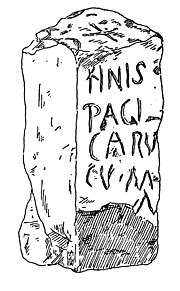Caerosi
The Caerosi (or Caeroesi) were a small Belgic-Germanic tribe that lived in Gallia Belgica during the Iron Age and the Roman period. Their ethnic identity remains uncertain. Caesar described them as part of the Germani Cisrhenani, but their tribal name is probably of Celtic origin.[1][2][3] Like other Germani Cisrhenani tribes, it is possible that their old Germanic endonym came to be abandoned after a tribal reorganization, that they received their names from their Celtic neighbours, or else that they were fully or partially assimilated into Celtic culture at the time of the Roman invasion of the region in 57 BC.[2]
Name
They are mentioned as Caerosos (var. ceroesos, caeroesos, cerosos) by Caesar (mid-1st c. BC),[4] and as Caerosi by Orosius (early 5th c. AD).[5][6][2]
The ethnonym Caerosi probably derives from a Proto-Celtic stem reconstructed as *caer- ('sheep'; cf. Old Irish caera), itself from an earlier *caper- (cf. Latin caper, Old Norse hafr, 'billy goat', Greek kápros 'boar'). The variant Caeroesi has an unexplained suffix (-oeso-), which is not found in either Celtic or Germanic languages, although -oso- is a known suffix in Gaulish (e.g. Laudosa, Iboso). It may be translated as 'the sheep', 'the rams', or else 'rich in sheep', although its exact meaning remains unclear.[7] It is linguistically related to other Celtic ethnonyms such as Caeracates, Caereni, and Kairènoi (Καιρηνοί).[1][3]

Alternative comparisons with the Old Irish cáera ('berry'),[8][9] the Middle Irish céar ('dark brown'),[2] or the Proto-Germanic *haira- ('worthy, exalted, *grey-haired’; cf. Mod. High German hehr 'noble') have also been proposed by some scholars.[9]
The region of pagus Carucum, a Roman-era subdivision of the Treveri later known under the Franks as Pagus Coroascus, may be named after the tribe,[10] although the linguistic connection remains uncertain.[11] The name has been discovered on a Roman era boundary marker carved with the inscription 'FINIS PAGI CARV CVM' ('boundary or end of the pagus Carucum'), located in a wooded area near Neidenbach and Kyllburg.[12]
Geography
The Caerosi lived in the Ardennes and Eifel region, between the Rhine and Meuse rivers, near the Treverii in the south, the Condrusi in the west, the Paemani and Eburones in the north, and the Ubii on the opposite bank of the Rhine in the east.[13]
To the east of Neidenbach, the Vinxtbach, a small river flowing eastwards to the Rhine, marked the boundary between the Roman provinces of Germania Superior and Germania Inferior. The name Vinxtbach is in fact thought to derive from the Latin word finis, meaning an end or boundary.[14] Today, the place is still a boundary between modern German dialects, with Ripuarian to the north, and Moselle Frankish to the south. Also located nearby is the modern boundary of the modern German Länder of Rheinland-Pfalz and Nordrhein-Westfalen.[citation needed]
References
- ^ a b Sergent 1991, pp. 10–11.
- ^ a b c d Neumann 1999, pp. 110–111.
- ^ a b Delamarre 2003, p. 97.
- ^ Caesar. Commentarii de Bello Gallico, 2:4:10.
- ^ Orosius. Historiae Adversus Paganos, 6:7:14.
- ^ Falileyev 2010, s.v. Caerosi.
- ^ Sergent 1991, pp. 10–11; Neumann 1999, pp. 110–111; Delamarre 2003, p. 97; Busse 2006, p. 199
- ^ Neumann 1981, p. 309.
- ^ a b Busse 2006, p. 199.
- ^ Wightman 1985, p. 31.
- ^ von Petrikovits 1999, p. 93.
- ^ Corpus Inscriptionum Latinarum 13, 4143.
- ^ Talbert 2000, Map 11: Sequana-Rhenus.
- ^ Matijević, Krešimir (2010). Römische und frühchristliche Zeugnisse im Norden Obergermaniens: epigraphische Studien zu unterer Mosel und östlicher Eifel. Verlag Marie Leidorf. pp. 237–239. ISBN 978-3-86757-255-2.
Primary sources
- Caesar (1917). The Gallic War. Loeb Classical Library. Translated by Edwards, H. J. Harvard University Press. ISBN 978-0-674-99080-7.
Bibliography
- Busse, Peter E. (2006). "Belgae". In Koch, John T. (ed.). Celtic Culture: A Historical Encyclopedia. ABC-CLIO. pp. 195–200. ISBN 978-1-85109-440-0.
- Delamarre, Xavier (2003). Dictionnaire de la langue gauloise: Une approche linguistique du vieux-celtique continental. Errance. ISBN 9782877723695.
- Falileyev, Alexander (2010). Dictionary of Continental Celtic Place-names: A Celtic Companion to the Barrington Atlas of the Greek and Roman World. CMCS. ISBN 978-0955718236.
- Neumann, Günter (1981), "Caeroesi", Reallexikon der Germanischen Altertumskunde (RGA), vol. 4 (2 ed.), Berlin/New York: Walter de Gruyter, pp. 309–310, ISBN 3-11-006513-4
- Neumann, Günter (1999), "Germani cisrhenani — die Aussage der Namen", in Beck, H.; Geuenich, D.; Steuer, H. (eds.), Germanenprobleme in heutiger Sicht, Walter de Gruyter, ISBN 978-3110164381
- Sergent, Bernard (1991). "Ethnozoonymes indo-européens". Dialogues d'Histoire Ancienne. 17 (2): 9–55. doi:10.3406/dha.1991.1932.
- Talbert, Richard J. A. (2000). Barrington Atlas of the Greek and Roman World. Princeton University Press. ISBN 978-0691031699.
- von Petrikovits, Harald (1999), "Germani Cisrhenani", in Beck, H.; Geuenich, D.; Steuer, H. (eds.), Germanenprobleme in heutiger Sicht, Walter de Gruyter, ISBN 978-3110164381
- Wightman, Edith M. (1985). Gallia Belgica. University of California Press. ISBN 978-0-520-05297-0.

